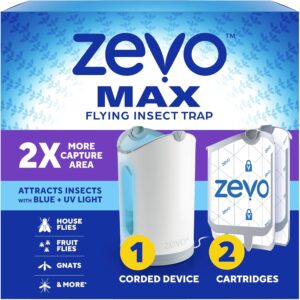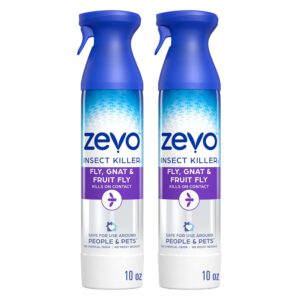Gnats are tiny, but they can be a big problem in your home or garden.
They spread fast, especially if you overwater plants, leave your drains dirty, or let ripe fruit sit out. Since they multiply quickly, it’s best to deal with them right away.
What is a Gnat?
Gnats are small flying bugs that often appear in groups. They can hover in one spot and are usually seen in kitchens, near damp houseplants, or around wet areas like drains. Here are the three most common types of gnats:
-
Fungus gnats are black with long legs. They usually show up around houseplants or gardens that are too wet.
-
Fruit flies are brown with red eyes and have round bodies. They’re attracted to ripe or rotting fruits and vegetables.
-
Drain flies look fuzzy and have wings like a moth. They like damp places such as drains, sewers, or puddles outside.
Read More: How to get rid of fruit flies in the house
How to Get Rid of Gnats in Your Home
If fruit flies are flying around your fruit or fungus gnats are swarming your plants, they won’t just leave on their own.
The good news is, there are easy ways to get rid of gnats fast.
This article includes affiliate links. If you make a purchase through these links, I may earn a commission at no extra cost to you. Your support is highly appreciated.
1. Use a bug zapper
Plug-in traps, such as the Zevo Flying Insect Trap, work well. These bug zappers use UV light to attract gnats and then trap them.
Most are safe to use indoors, so you can place one near where you see the gnats.
Check these Out on Amazon
Zevo MAX Bug Catcher & Fly Trap for Indoors

2. Make a vinegar trap
This home remedy works well, and you probably already have everything you need. Our cleaning experts recommend these three simple vinegar traps to kill gnats:

1. Plastic wrap trap with apple cider vinegar: Pour some apple cider vinegar into a glass or leave the bottle open. Cover the top with plastic wrap, secure it with a rubber band, and poke a few small holes. The flies will go in but won’t be able to get out.
2. Paper cone trap with vinegar and fruit: Put some vinegar and a piece of very ripe fruit in a jar. Roll a piece of paper into a cone and place it in the jar with the narrow end down. The smell will attract the flies, but the cone makes it hard for them to escape.
3. Vinegar and dish soap bowl: Mix a few drops of dish soap into a bowl of vinegar and leave it uncovered where gnats are a problem. The soap breaks the surface tension, so the flies sink and drown after landing.
Also Check: Smart Things to Add to Your Study Desk
3. Pour boiling water down the drain
Drains are a common hiding place for gnats. Even if you don’t have baking soda, vinegar, or drain cleaner, you can still fight them by pouring boiling water down the sink.
This kills their eggs and helps clear out leftover food and bacteria.
4. Try a spray solution
Buy an insect spray that’s safe to use indoors. One good option is the Zevo Fly, Gnat & Fruit Fly Spray, which uses plant-based ingredients like geraniol and lemongrass oil to kill gnats instantly.
It’s safe to use around people and pets, but be careful not to spray it on your skin or in your eyes. Also, never use it near anything electrical since it’s flammable.

5. Buy a natural trap
If you want a gnat trap that’s safe to use around food, people, and pets, try Aunt Fannie’s FlyPunch.
It contains sodium lauryl sulfate (a soap ingredient) and malic acid (found in fruit). Just open the container, place it on your counter, and let it do the work.
6. Put out a beer or wine trap
Fruit flies are also drawn to the smell of beer and wine, just like vinegar. You can leave out an open bottle with a little bit of stale beer or old wine. The narrow bottleneck helps trap the flies inside.
7. Rely on sticky traps
Sticky traps are a simple way to catch lots of gnats. You can hang them like ribbons or use ones made for potted plants.
Gnats are drawn to bright colors, especially yellow. Just check the trap often and replace it when it gets full.
8. Make a candle trap
Put a tall candle in a candlestick and place it in a small water-filled pan. Add a little dish soap to the water and set the pan on your counter.
Light the candle and turn off the lights. Gnats will be attracted to the flame and either fly into it or fall into the soapy water and drown.
Stay in the room while the candle is burning and watch it until you’re ready to blow it out.
Read More: How to Get Rid of Ants in the House
How to Get Rid of Gnats Outside
Many of the methods above, like using vinegar traps and sticky traps, can help keep gnats away from your garden and outdoor areas.
But there are other things you can do outside to stop gnats from taking over:
1. Identify the Source
Gnats are usually drawn to damp soil, decaying organic matter, or areas with standing water.
To effectively get rid of them, start by checking your outdoor space for moist spots, compost piles, overwatered plants, or any other places where moisture collects and organic debris accumulates. Pinpointing the source helps target your efforts more efficiently.
2. Reduce Attractants
Once you identify where gnats are coming from, reduce the factors that attract them. Remove any rotting fruit, fallen leaves, or other organic waste that might be lying around.
Be careful not to overwater your plants—allow the soil to dry out between watering sessions to discourage gnat breeding.
Also, fix any areas with standing water, such as clogged gutters or birdbaths, since stagnant water is a prime breeding ground.
3. Use Natural Remedies
Natural traps work well to catch and reduce gnat populations. For instance, filling a small bowl with apple cider vinegar mixed with a drop of dish soap creates an effective trap—gnats are attracted to the vinegar scent, and the soap breaks the surface tension so they drown.
You can also use red wine as an attractant in a similar trap. Additionally, placing yellow sticky traps near plants can capture flying gnats before they lay eggs.
4. Use Soil Treatments
Treating the soil can help eliminate gnat larvae before they become adults. Sprinkling cinnamon on the soil acts as a natural fungicide and repels gnats.
For a more biological approach, beneficial nematodes or Bacillus thuringiensis israelensis (BTI) granules can be applied to the soil to specifically target and kill gnat larvae without harming plants.
5. Encourage Natural Predators
Encouraging natural predators is a great way to keep gnat populations in check over time.
Birds and beneficial insects like ladybugs feed on gnats and their larvae, so creating a welcoming environment for these predators can help reduce gnat numbers naturally.
6. Chemical Solutions (if necessary)
If gnats persist despite your efforts, you might consider using insecticidal sprays designed to control gnats outdoors.
However, it’s best to use chemical treatments as a last resort and follow all safety instructions carefully to avoid harming beneficial insects and the environment.
How to Prevent Gnats
1. Minimize moisture
Gnats like moist and humid places, so using a dehumidifier in damp parts of your home can help keep them away.
2. Don’t let garbage build up
Gnats are attracted to trash and rotting fruit left in your home. To stop them, keep your counters clean and take out the garbage every day.
3. Don’t overwater houseplants
“Fungus gnat infestations are often caused by sources of damp soil, such as houseplants, or decaying or damaged plant roots,” says Dr. Jim Fredericks, a board-certified entomologist and senior vice president of public affairs at the National Pest Management Association (NPMA).
To prevent fungus gnats, regularly repot your houseplants in new soil and ease up on overwatering them.
4. Keep drains clean
Drain flies like places with bacteria, sewage, and dirt. You’ll often find them in kitchen and bathroom drains, garbage disposals, and toilets that aren’t used much.
To stop drain flies, clean your drains and plumbing often, especially in humid summer weather.
5. Store fruit properly
To keep fruit flies away, rinse and dry your fruits and vegetables right after you bring them home. Store them in bins or the fridge when you can.
Fast-ripening fruits like apples, grapes, melons, pears, peaches, and plums should go in the low-humidity drawer.
Leafy greens and broccoli, which wilt easily, do better in the high-humidity drawer.
Bananas are best kept on the counter, but once ripe, you can put them in the fridge or peel and freeze them.

